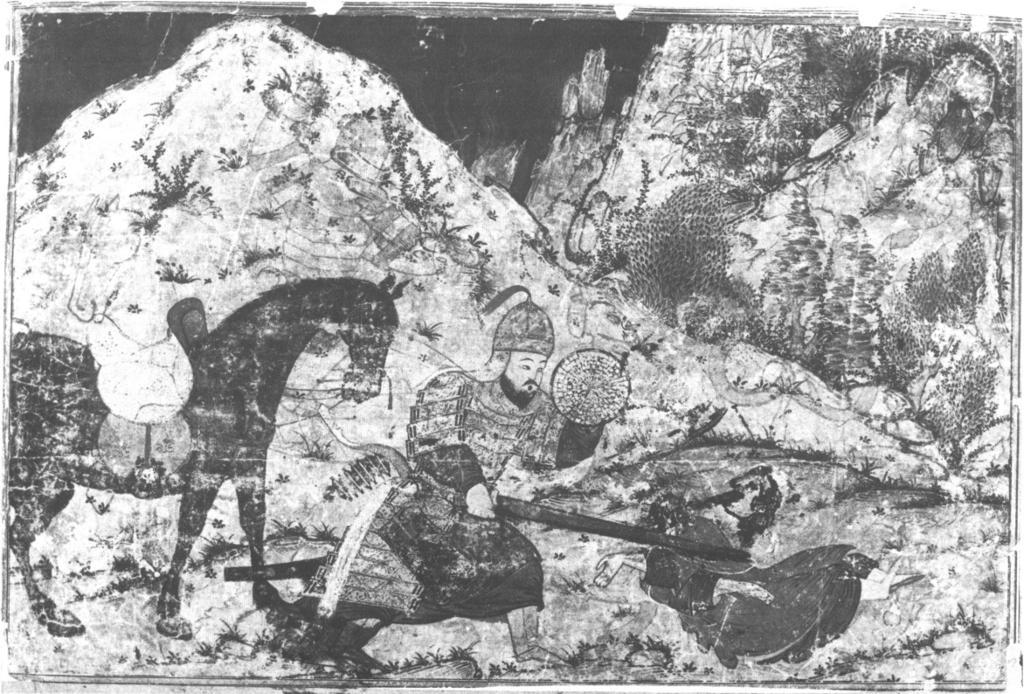Amazon Prime Student 6-month Trial

Try Amazon Fresh
Isfandiyar Killing Gūl, a Witch Capable of Transforming Days into Nights
Illustration of Jalayrids from a late 14th Century Shahnama
From Manuscript Hazine 2160, of the Saray Albums, Topkapi Palace Museum, Istanbul Turkey

A larger image of Isfandiyār Killing Gūl. Topkapi Saray Museum, folio 76b.
Source: Plate 48 in: M. GORELIK, "Oriental Armour of the Near and Middle East from the Eighth to the Fifteenth Centuries as Shown in Works of Art", in: Islamic Arms and Armour, ed. ROBERT ELGOOD, London 1979
48 Miniature from Shāh-Nāmeh, Tabriz, c.1370-1380. (Topkapu Saray Museum. Hazine 2160, fol. 76b)
Isfandiyār Killing Gūl, a Witch Capable of Transforming Days into Nights; Fourth Stage (fig. 5)
Isfandiyār and his soldier pitch camp on the banks of a brook.
After dining, Gurgsar tells him that he will meet Gūl, a witch who can change days into nights.
They at once take down their tents and set out that same night.
A little later Prince Isfandiyār enters a dark, beautiful forest with a gold bowl and valuable lute and starts singing.
The witch approaches him in the guise of a pretty Turkman girl.
Filled with admiration for her, Isfandiyār offers her wine.
Then he slips a steel chain he had kept hidden from her around her neck.
This renders her helpless, and she takes the appearance of a lion.
Drawing his dagger, Isfandiyār tells her to take her original shape.
As soon as she appears as a black-faced, white-haired hag, he beheads her.
Isfandiyār stands in the center foreground, dressed in a gold helmet, red and
black decorated coat of mail covering his dark-blue clothes.
In one hand he holds a sword, in the other his shield.
Most of his horse is visible.
The body of the witch, dressed in red and green, lies before him.
On the beige ground there are tufts of grass; behind the mountain on the left the sky can be seen.
Light-green colored trees are concentrated at the point where two mountains meet.
In the unpainted upper left-hand corner Kar-i Sunullah (the work of Sunullah)
and on the piece of paper stuck on the upper right-hand corner Kar-i Dervish Muhammad (the work of Dervish Muhammad) is written.
The painting, for which dull and faded colors were used, is rather worn.
The traces of earlier figures roughly drawn are faintly visible: under Isfandiyar one can discern an outline of a figure in armor and a horse facing the other direction.
This figure looks back with one arm lifted.
Opposite it there are a few lines that may have been the beginning of a dragon.
Movement has been given to the skyline with hills and boulders.
Text source: "Four Istanbul Albums and Some Fragments from Fourteenth-Century Shah-Namehs" by Nurhan Atasoy, pp. 19-48 in Ars orientalis; the arts of Islam and the East Vol. 8 (1970)
Back to Illustrations of Jalayrid Mongols


